Cite this document
(Laboratory Report about stress Lab Example | Topics and Well Written Essays - 2000 words, n.d.)
Laboratory Report about stress Lab Example | Topics and Well Written Essays - 2000 words. https://studentshare.org/engineering-and-construction/1856568-laboratory-report-about-stress
Laboratory Report about stress Lab Example | Topics and Well Written Essays - 2000 words. https://studentshare.org/engineering-and-construction/1856568-laboratory-report-about-stress
(Laboratory Report about Stress Lab Example | Topics and Well Written Essays - 2000 Words)
Laboratory Report about Stress Lab Example | Topics and Well Written Essays - 2000 Words. https://studentshare.org/engineering-and-construction/1856568-laboratory-report-about-stress.
Laboratory Report about Stress Lab Example | Topics and Well Written Essays - 2000 Words. https://studentshare.org/engineering-and-construction/1856568-laboratory-report-about-stress.
“Laboratory Report about Stress Lab Example | Topics and Well Written Essays - 2000 Words”. https://studentshare.org/engineering-and-construction/1856568-laboratory-report-about-stress.


